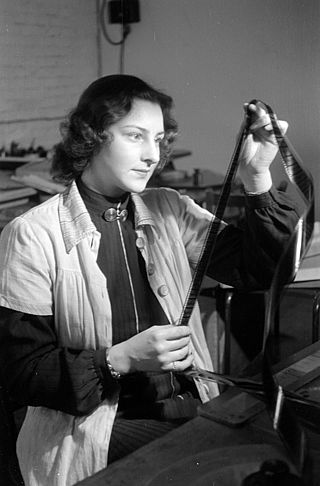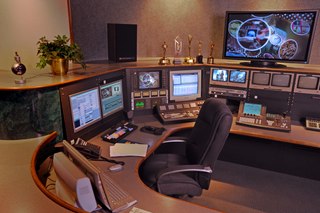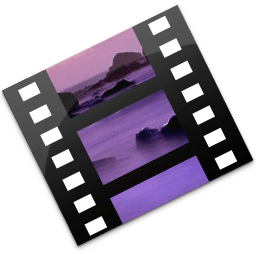
Film editing is both a creative and a technical part of the post-production process of filmmaking. The term is derived from the traditional process of working with film which increasingly involves the use of digital technology. When putting together some sort of video composition, typically, you would need a collection of shots and footages that vary from one another. The act of adjusting the shots you have already taken, and turning them into something new is known as film editing.
In film editing, an L cut is a variant of a split edit technique in which the audio from preceding scene overlaps the picture from the following scene, so that the audio cuts after the picture, and continues playing over the beginning of the next scene.

Video editing software or a video editor is software used for performing the post-production video editing of digital video sequences on a non-linear editing system (NLE). It has replaced traditional flatbed celluloid film editing tools and analog video tape editing machines.

Non-linear editing is a form of offline editing for audio, video, and image editing. In offline editing, the original content is not modified in the course of editing. In non-linear editing, edits are specified and modified by specialized software. A pointer-based playlist, effectively an edit decision list (EDL), for video and audio, or a directed acyclic graph for still images, is used to keep track of edits. Each time the edited audio, video, or image is rendered, played back, or accessed, it is reconstructed from the original source and the specified editing steps. Although this process is more computationally intensive than directly modifying the original content, changing the edits themselves can be almost instantaneous, and it prevents further generation loss as the audio, video, or image is edited.

Post-production is part of the process of filmmaking, video production, audio production, and photography. Post-production includes all stages of production occurring after principal photography or recording individual program segments.
Video editing is the post-production and arrangement of video shots. To showcase perfect video editing to the public, video editors must be reasonable and ensure they have a superior understanding of film, television, and other sorts of videography. Video editing structures and presents all video information, including films and television shows, video advertisements and video essays. Video editing has been dramatically democratized in recent years by editing software available for personal computers. Editing video can be difficult and tedious, so several technologies have been produced to aid people in this task. Overall, video editing has a wide variety of styles and applications.

iMovie is a free video editing application made by Apple for the Mac, the iPhone, and the iPad. It includes a range of video effects and tools like color correction and image stabilization, but is designed to be accessible to users with little or no video editing experience. iMovie's professional equivalent is Apple's Final Cut Pro X.

Final Cut Pro is a professional non-linear video-editing application initially developed by Macromedia, and, since 1998, by Apple as part of its pro apps collection. Final Cut Pro allows users to import, edit, and process video footage, and output it to a wide variety of formats.

A film transition is a technique used in the post-production process of film editing and video editing by which scenes or shots are combined. Most commonly this is through a normal cut to the next shot. Most films will also include selective use of other transitions, usually to convey a tone or mood, suggest the passage of time, or separate parts of the story. These other transitions may include dissolves, L cuts, fades, match cuts, and wipes.

Adobe Premiere Pro is a timeline-based non-linear video editing application developed by Adobe Inc. and distributed through the Adobe Creative Cloud licensing program. Initially released in 2003, it succeeded Adobe Premiere, which was first introduced in 1991. Premiere Pro is designed for professional video editing, whereas related product Premiere Elements is aimed at the consumer market.

Windows Movie Maker is a discontinued video editing software program by Microsoft. It was first included in Windows Me on September 14, 2000, and in Windows XP on October 25, 2001. It later became a part of the Windows Essentials software suite, and offered the ability to create and edit videos as well as to publish them on OneDrive, Facebook, Vimeo, YouTube, Windows Live Groups, and Flickr. It is comparable to Apple's iMovie.

In the post-production process of film and video editing, a dissolve is a type of film transition in which one sequence fades over another. The terms fade-out and fade-in are used to describe a transition to and from a blank image. This is in contrast to a cut, where there is no such transition. A dissolve overlaps two shots for the duration of the effect, usually at the end of one scene and the beginning of the next, but may also be used in montage sequences. Generally, but not always, the use of a dissolve is held to indicate that a time has passed between the two scenes. Also, it may indicate a change of location or the start of a flashback.
Offline editing is the creative storytelling stage of film making and television production where the structure, mood, pacing and story of the final show are defined. Many versions and revisions are presented and considered at this stage until the edit gets to a stage known as picture lock. This is when the process then moves on to the next stages of post production known as online editing, colour grading and audio mixing.
This article contains a list of cinematic techniques that are divided into categories and briefly described.
Shot transition detection also called cut detection is a field of research of video processing. Its subject is the automated detection of transitions between shots in digital video with the purpose of temporal segmentation of videos.
In the post-production process of film editing and video editing, a cut is an abrupt, but usually trivial film transition from one sequence to another. It is synonymous with the term edit, though "edit" can imply any number of transitions or effects. The cut, dissolve, and wipe serve as the three primary transitions. The term refers to the physical action of cutting film or videotape, but also refers to a similar edit performed in software; it has also become associated with the resulting visual "break".
Articles related to the field of motion pictures include:

YouTube thumb
In film editing, a split edit is a film transition from one shot to another in which transition of the audio and video happen at different times. This is often done to enhance the aesthetics or flow of the film, allowing the audience to see context either before or after of speaking rather than simply the speaking itself. Without split edit, a conversation between two people can feel like a tennis match.
This glossary of motion picture terms is a list of definitions of terms and concepts related to motion pictures, filmmaking, cinematography, and the film industry in general.








